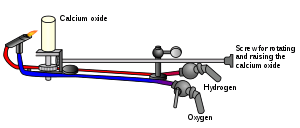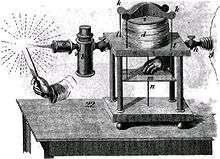Oxyhydrogen
Oxyhydrogen is a mixture of hydrogen (H2) and oxygen (O2) gases. This gaseous mixture is used for torches to process refractory materials and was the first[1] gaseous mixture used for welding. Theoretically, a ratio of 2:1 hydrogen:oxygen is enough to achieve maximum efficiency; in practice a ratio 4:1 or 5:1 is needed to avoid an oxidizing flame.[2]

This mixture may also be referred to as Knallgas (Scandinavian and German Knallgas: "bang-gas"), although some authors define knallgas to be a generic term for the mixture of fuel with the precise amount of oxygen required for complete combustion, thus 2:1 oxyhydrogen would be called "hydrogen-knallgas".[3]
"Brown's gas" and HHO are terms for oxyhydrogen mainly encountered in fringe science.[4]
Properties
Oxyhydrogen will combust when brought to its autoignition temperature. For the stoichiometric mixture, 2:1 hydrogen:oxygen, at normal atmospheric pressure, autoignition occurs at about 570 °C (1065 °F).[5] The minimum energy required to ignite such a mixture with a spark is about 20 microjoules.[5] At standard temperature and pressure, oxyhydrogen can burn when it is between about 4% and 95% hydrogen by volume.[6][5]
When ignited, the gas mixture converts to water vapor and releases energy, which sustains the reaction: 241.8 kJ of energy (LHV) for every mole of H2 burned. The amount of heat energy released is independent of the mode of combustion, but the temperature of the flame varies.[7] The maximum temperature of about 2,800 °C (5,100 °F) is achieved with an exact stoichiometric mixture, about 700 °C (1,300 °F) hotter than a hydrogen flame in air.[8][9][10] When either of the gases are mixed in excess of this ratio, or when mixed with an inert gas like nitrogen, the heat must spread throughout a greater quantity of matter and the temperature will be lower.[7]
Production
A pure stoichiometric mixture may be obtained by water electrolysis, which uses an electric current to dissociate the water molecules:
- electrolysis: 2 H2O → 2 H2 + O2
- combustion: 2 H2 + O2 → 2 H2O
William Nicholson was the first to decompose water in this manner in 1800. In theory, the input energy of a closed system will always equal the output energy, as the first law of thermodynamics states. However, in practice no systems are perfectly closed, and the energy required to generate the oxyhydrogen will always exceed the energy released by combusting it, even at maximum practical efficiency, as the second law of thermodynamics implies (see Electrolysis of water#Efficiency).
Applications

Lighting
Many forms of oxyhydrogen lamps have been described, such as the limelight, which used an oxyhydrogen flame to heat a piece of lime to white hot incandescence.[11] Because of the explosiveness of the oxyhydrogen, limelights have been replaced by electric lighting.
Oxyhydrogen blowpipe

The foundations of the oxy-hydrogen blowpipe were laid down by Carl Wilhelm Scheele and Joseph Priestley around the last quarter of the eighteenth century. The oxy-hydrogen blowpipe itself was developed by the Frenchman Bochard-de-Saron, the English mineralogist Edward Daniel Clarke and the American chemist Robert Hare in the late eighteenth and early nineteenth centuries.[12] It produced a flame hot enough to melt such refractory materials as platinum, porcelain, fire brick, and corundum, and was a valuable tool in several fields of science.[13] It is used in the Verneuil process to produce synthetic corundum.[14]
Oxyhydrogen torch
An oxyhydrogen torch (also known as hydrogen torch) is an oxy-gas torch that burns hydrogen (the fuel) with oxygen (the oxidizer). It is used for cutting and welding[15] metals, glasses, and thermoplastics.[11]
Due to competition from arc welding and the acetylene-fueled cutting torch, the oxyhydrogen torch is seldom used today, but it remains the preferred cutting tool in some niche applications (see oxy-fuel welding and cutting).
Oxyhydrogen was once used in working platinum, because at the time, only it could burn hot enough to melt the metal 1,768.3 °C (3,214.9 °F).[7] These techniques have been superseded by the electric arc furnace.
Fringe science
Brown's gas is associated with various exaggerated claims.[16][17] It is often called "HHO gas", a term popularized by fringe physicist[18] Ruggero Santilli, who claimed that his HHO gas, produced by a special apparatus, is "a new form of water", with new properties, based on his fringe theory of "magnecules".[17]
Many other pseudoscientific claims have been made about Brown's gas, like an ability to neutralize radioactive waste, help plants to germinate, and more.[17] However, it is well known that hydrogen ions form the basis of pH balance in any solution, which can explain why this form of water may help seeds to obtain their germinated states in some cases.[19]
Oxyhydrogen is often mentioned in conjunction with vehicles that claim to use water as a fuel. The most common and decisive counter-argument against producing this gas on board to use as a fuel or fuel additive is that more energy is always needed to split water molecules than is recouped by burning the resulting gas.[16][20] Additionally, the volume of gas that can be produced for on-demand consumption through electrolysis is very small in comparison to the volume consumed by an internal combustion engine.[21]
An article in Popular Mechanics reported that Brown's gas does not increase the fuel economy in automobiles.[22]
"Water-fueled" cars should not be confused with hydrogen-fueled cars, where the hydrogen is produced elsewhere and used as fuel or where it is used as fuel enhancement.
References
- Howard Monroe Raymond (1916), "Oxy-Hydrogen Welding", Modern Shop Practice volume 1, American Technical Society, archived from the original on March 6, 2011
- Viall, Ethan (1921). Gas Torch and Thermite Welding. McGraw-Hill. p. 10. Archived from the original on August 3, 2016.
- W. Dittmar, "Exercises in quantitative chemical analysis", 1887, p. 189 Archived June 27, 2014, at the Wayback Machine
- "Eagle Research Institute - Brown's Gas - Myth-conceptions". Archived from the original on April 18, 2019. Retrieved July 11, 2018.
- O'Connor, Ken. "Hydrogen" (PDF). NASA Glenn Research Center Glenn Safety Manual (PDF). Archived from the original on February 2, 2013.CS1 maint: BOT: original-url status unknown (link)
- Moyle, Morton; Morrison, Richard; Churchill, Stuart (March 1960). "Detonation Characteristics of Hydrogen Oxygen Mixtures" (PDF). AIChE Journal. 6: 92–96. doi:10.1002/aic.690060118. hdl:2027.42/37308.
- Chisholm, Hugh, ed. (1911). . Encyclopædia Britannica. 20 (11th ed.). Cambridge University Press. p. 424.
-
Calvert, James B. (April 21, 2008). "Hydrogen". University of Denver. Archived from the original on April 18, 2009. Retrieved April 23, 2009.
An air-hydrogen torch flame reaches 2045 °C, while an oxyhydrogen flame reaches 2660 °C.
- "Adiabatic Flame Temperature". The Engineering Toolbox. Archived from the original on January 28, 2008. Retrieved April 23, 2009. "Oxygen as Oxidizer: 3473 K, Air as Oxidizer: 2483 K"
- "Temperature of a Blue Flame". Archived from the original on March 16, 2008. Retrieved April 5, 2008. "Hydrogen in air: 2,400 K, Hydrogen in Oxygen: 3,080 K"
- Tilden, William Augustus (1926). Chemical Discovery and Invention in the Twentieth Century. Adamant Media Corporation. p. 80. ISBN 978-0-543-91646-4.
- Hofmann, A. W. (1875). "Report on the Development of the Chemical Arts During the Last Ten Years". Chemical News. Manufacturing chemists.
- Griffin, John Joseph (1827). A Practical Treatise on the Use of the Blowpipe in Chemical and Mineral Analysis. Glasgow: R. Griffin & co.
- "Verneuil process". Encyclopaedia Britannica. October 22, 2013. Retrieved July 11, 2018.
- P. N. Rao (2001), "24.4 Oxyhydrogen welding", Manufacturing technology: foundry, forming and welding (2 ed.), Tata McGraw-Hill Education, pp. 373–374, ISBN 978-0-07-463180-5, archived from the original on June 27, 2014
- Ball, Philip (September 10, 2007). "Burning water and other myths". News@nature. Springer Nature. doi:10.1038/news070910-13. ISSN 1744-7933.
- Ball, Philip (2006). "Nuclear waste gets star attention". News@nature. doi:10.1038/news060731-13. ISSN 1744-7933.
- Weimar, Carrie (May 7, 2007). "Snubbed By Mainstream, Scientist Sues". St. Petersburg Times. Retrieved February 3, 2011.
- Poel, L. W. (April 1949). "Germination and Development of Heather and the Hydrogen Ion Concentration of the Medium". Nature. 163 (4147): 647–648. doi:10.1038/163647b0. ISSN 1476-4687.
- Schadewald, R.J. (2008). Worlds of Their Own: A Brief History of Misguided Ideas: Creationism, Flat-Earthism, Energy Scams, and the Velikovsky Affair. Xlibris US. ISBN 978-1-4628-1003-1. Retrieved July 11, 2018.
- Simpson, Bruce (May 2008). "The proof that HHO is a scam". Aardvark Daily. Archived from the original on February 11, 2012. Retrieved February 12, 2012.
- Water-Powered Cars: Hydrogen Electrolyzer Mod Can't Up MPGs Archived March 20, 2015, at the Wayback Machine, Mike Allen, August 7, 2008, Popularmechanics.com